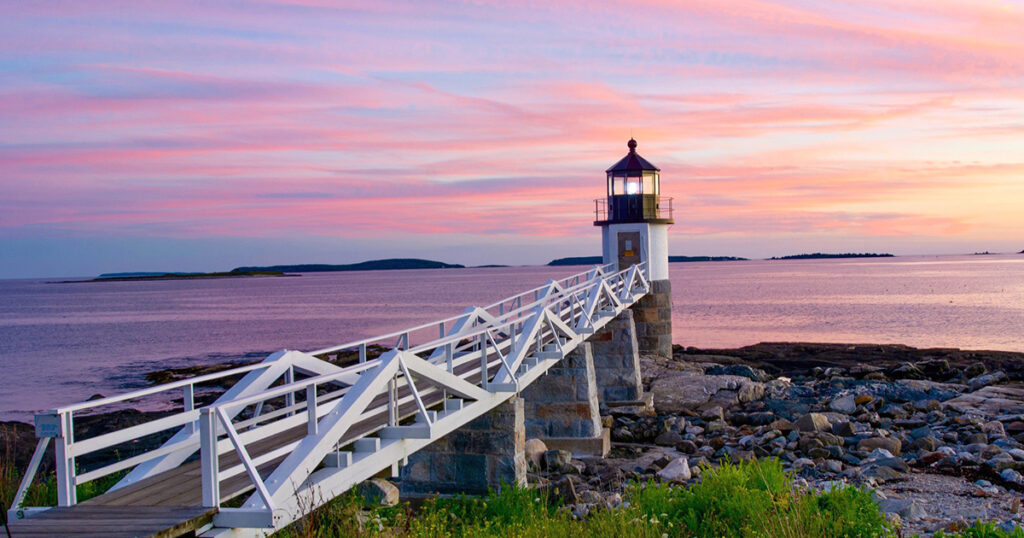
If you must self-quarantine for 14 days—as Maine’s governor Janet T. Mills requires of out-of-state visitors—this is as good a place as any: seated on an Adirondack rocker next to a picture window overlooking the endless expanse of the North Atlantic, punctuated by a lighthouse and an occasional evergreen in the foreground, with Monhegan Island in the middle distance.
Coastal Maine’s notorious fog sometimes clouds the view, but fog can also feed the imagination—allowing us to see things that are never quite there. With no clear horizon visible in the mist, sightlines might as well be infinite. Yes, 3,000 miles over the sea lies Europe. Much closer is the unseen virus.
What can obstruct my view, however, are other people. They stop and stare. Not at me, but at the same view I’m enjoying. The rocky cliff dropping into the Gulf of Maine invariably gets their attention as they stroll and snap photos along the small public right-of-way that runs directly in front of my seasonal cottage.
In pre-pandemic times, when visiting here, I found their presence annoying. Not only did they occasionally block the view; their clothes and behavior, more often than not, branded them as easy-to-mock, unaware tourists trespassing on the beauty of nature. From behind the glass of my slightly elevated picture window, I stared at them—literally looked down on them and their ignorance of being on parade, targets in someone’s sightlines.
I judged them, I must confess. Like a birder with binoculars, I identified personalities by the plumage of their leggings or the tilt of their hats. Like a naturalistic novelist portraying individual characters through physical description, I could be cruel in my assessments—for example, “He has the belly of a toad.” From such signifiers, I was even presumptuous enough to guess how they might vote.
Their presence was the price I paid for my seasonal cottage’s location—in Realtor argot, “ocean view,” not “oceanfront,” meaning I didn’t have to pay the substantially higher annual real estate tax had the property been “oceanfront” with no public right-of-way.
But coronavirus reframes everything, and I’m now thinking the previously unthinkable: that other people’s presence actually enhances the view. They and I are now sharing not only the same prospect but also a common enemy. They may all be asymptomatic carriers not wearing masks, but they remain sufficiently “socially distant,” on the other side of my PPD (Personal Protection Device) of a double-glazed glass window. As I observe them observing what they behold as beautiful, I realize that we’re all bearing witness to what makes us human.
My window is not a two-way mirror (as found in police interrogation rooms), so they can watch me watching them; all they have to do is turn around. Most passersby keep looking at the ocean. The few who do catch me spying on them register surprise but never anger. They almost always smile and wave.
I wave back. It’s not something I decide to do; my right arm lifts automatically and my wrist swings my hand. And I smile, too.
The street-fronting picture window’s transparency, blurring boundaries between private and public, was a signature architectural motif of 1950s suburban America. What better way to encourage social control and conformity? asked cultural critics. But my window, I like to think, is more eccentric—filling a 20-square-foot space recently carved out of this 100-year-old cabin’s log wall by a previous owner.
Still, for the people who do look, I’m as much on display as an animal in a cage. Instead of a lion pacing back and forth, I am an unshaven, unkempt human rocking in a peeled-paint Adirondack. Perhaps I come across as a minor character actor on a TV or computer screen. For both the electronic screen and the picture window, the aspect ratio is roughly the same: one measured in inches or centimeters, the other in feet or meters.
To snap a photo of the view, as many of them do, means turning their cellphones into yet another frame. According to the social science concept known as “framing” or “frame analysis,” how something is framed determines the way we see it. The way a question is posed predicts the possible answers. Framing, in short, is the way we organize experience.
Framing also helps explain our increasingly polarized society. Yet in this Time of Corona on the rocky coastline of the Gulf of Maine, everyone seems to be enjoying the same frame, taking comfort in what the eyes can see—the universality of natural beauty, especially the still unspoiled sea. But what can’t be so reassuringly framed is what remains unseen.

